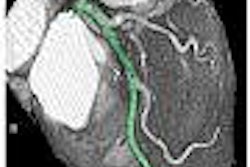TORONTO - A pair of studies at yesterday's Society of Nuclear Medicine (SNM) meeting found that PET and PET/CT offer superior performance compared to bone scintigraphy scans in detecting bony metastases from primary breast cancer. But bone scintigraphy still offers better performance in a couple areas and may continue to play a diagnostic role due to its low cost.
In the first study, researchers from Albany Medical College in Albany, NY, compared FDG-based PET to bone scintigraphy with technetium-99m methylene diphosphonate (MDP) in detecting bone cancer that had originated in the breast or in the lung. They were hoping to determine the extent to which patient management could be changed based on PET results and wanted answers to several clinical questions, according to Dr. Maroun Karam.
For example, they wanted to see whether PET could be used alone without bone scans. Another question regarded whether PET's superior performance was due to the types of cancers being imaged.
The retrospective study examined 44 patients with metastatic lung cancer and 32 with metastatic breast cancer. PET scans were viewed by one nuclear medicine physician and the bone scans by another nuclear physician, with each blinded to cancer type and the other's findings.
In 19 of 44 patients with metastatic lung cancer, PET showed more foci of disease than bone scan, and bone scan showed no sign of disease in eight of these patients. Bone scan showed more foci in 6/44, with PET showing no sign of disease in one patient in which the lesion was outside the standard PET field-of-view. The two modalities were equal in 12 patients. PET chalked up a sensitivity of 97% while bone scintigraphy's sensitivity was 78%.
Among the patients with metastatic breast cancer, PET was more sensitive than bone scintigraphy in 15 of 32 patients, with bone scan showing no sign of disease in four patients. Bone scan showed more disease foci in four of the 32, and the two were equal in six patients. PET's sensitivity was 96% while bone scintigraphy turned in 87%.
The group found that PET's superior performance was not related to the type of cancer being studied, Karam said. PET is also more specific than bone scan in patients with no metastatic disease.
In the discussion period, Karam was queried on the use of planar scintigraphy in the study for bone scans rather than a more advanced SPECT/CT technique. Karam acknowledged that SPECT/CT would produce better images, but would probably be cost-prohibitive for bone scanning.
"I'm sure the results of bone scanning would be improved greatly by doing SPECT, but how many of us do SPECT bone scanning for metastatic disease," he said. "If you start doing SPECT/CT on every patient to rule out metastatic disease, the cost is about the same as a PET scan so you might as well do a PET scan."
In the second study, researchers from the Catholic University of Korea in Seoul, South Korea, presented a study that compared PET/CT to bone scintigraphy in assessing bony metastases from primary breast cancer. They hoped to determine whether each modality had strengths and weaknesses based on the anatomical location of the metastases, as well as whether the CT component of PET/CT aided the modality's performance.
They studied 56 patients retrospectively with PET/CT and bone scintigraphy. Seven patients had PET/CT and bone scan after chemotherapy to evaluate their response to treatment, according to Dr. Chung Ho Kim.
PET/CT found 185 lesions, of which 178 were true positive and seven were false positive. Bone scan found 182 lesions, but only 155 of these were true positive, with 27 false positive. Of 199 metastases, 19 were found only with bone scan, while 42 were only detected with PET/CT.
PET/CT's sensitivity was 89.4% compared with bone scintigraphy's 77.9%. PET/CT showed a major advantage in specificity, with the modality recording 87.3% versus bone scintigraphy's 50.9%. PET/CT's positive predictive value was 96.2% versus 85.2% for bone scanning, while PET/CT's negative predictive value was 76.7% versus 38.9% for bone scanning.
Bone scintigraphy did outperform PET/CT in one region, however: the ribs. Bone scintigraphy scored a sensitivity of 90% versus 78.8% for PET/CT. The group found that CT images can be helpful when PET is equivocal, resulting in increased diagnostic value. They concluded by advocating a complementary role for PET/CT and bone scintigraphy.
During the discussion period, several session attendees recommended that PET/CT's performance was good enough that bone scintigraphy could be jettisoned altogether. Although bone scintigraphy performed better in the ribs, it's probably rare that a patient has metastases only in that location, one attendee said.
Kim countered, however, by pointing out the economic advantages of bone scintigraphy. "It costs $1,000 for a PET scan in Korea, and only $30 for a bone scan," he said. "Why not both?"
By Brian Casey
AuntMinnie.com staff writer
June 20, 2005
Related Reading
Zoledronic acid reduces skeletal complications of metastasis breast cancer, June 16, 2005
Shorter duration radiotherapy suitable for palliation of painful bone metastases, June 8, 2005
Copyright © 2005 AuntMinnie.com




















